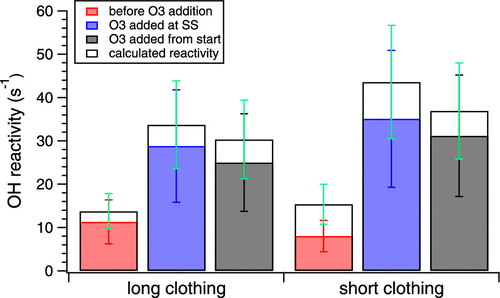当前位置:
X-MOL 学术
›
Environ. Sci. Technol.
›
论文详情
Our official English website, www.x-mol.net, welcomes your
feedback! (Note: you will need to create a separate account there.)
Effect of Ozone, Clothing, Temperature, and Humidity on the Total OH Reactivity Emitted from Humans
Environmental Science & Technology ( IF 10.8 ) Pub Date : 2021-09-30 , DOI: 10.1021/acs.est.1c01831 Nora Zannoni 1 , Mengze Li 1 , Nijing Wang 1 , Lisa Ernle 1 , Gabriel Bekö 2 , Pawel Wargocki 2 , Sarka Langer 3, 4 , Charles J Weschler 2, 5 , Glenn Morrison 6 , Jonathan Williams 1
Environmental Science & Technology ( IF 10.8 ) Pub Date : 2021-09-30 , DOI: 10.1021/acs.est.1c01831 Nora Zannoni 1 , Mengze Li 1 , Nijing Wang 1 , Lisa Ernle 1 , Gabriel Bekö 2 , Pawel Wargocki 2 , Sarka Langer 3, 4 , Charles J Weschler 2, 5 , Glenn Morrison 6 , Jonathan Williams 1
Affiliation

|
People influence indoor air chemistry through their chemical emissions via breath and skin. Previous studies showed that direct measurement of total OH reactivity of human emissions matched that calculated from parallel measurements of volatile organic compounds (VOCs) from breath, skin, and the whole body. In this study, we determined, with direct measurements from two independent groups of four adult volunteers, the effect of indoor temperature and humidity, clothing coverage (amount of exposed skin), and indoor ozone concentration on the total OH reactivity of gaseous human emissions. The results show that the measured concentrations of VOCs and ammonia adequately account for the measured total OH reactivity. The total OH reactivity of human emissions was primarily affected by ozone reactions with organic skin-oil constituents and increased with exposed skin surface, higher temperature, and higher humidity. Humans emitted a comparable total mixing ratio of VOCs and ammonia at elevated temperature-low humidity and elevated temperature-high humidity, with relatively low diversity in chemical classes. In contrast, the total OH reactivity increased with higher temperature and higher humidity, with a larger diversity in chemical classes compared to the total mixing ratio. Ozone present, carbonyl compounds were the dominant reactive compounds in all of the reported conditions.
中文翻译:

臭氧、衣服、温度和湿度对人体总 OH 反应性的影响
人们通过呼吸和皮肤排放的化学物质影响室内空气化学。先前的研究表明,直接测量人类排放物的总 OH 反应性与通过平行测量呼吸、皮肤和全身的挥发性有机化合物 (VOC) 计算得出的结果相匹配。在这项研究中,我们通过由四名成年志愿者组成的两个独立小组的直接测量,确定了室内温度和湿度、衣服覆盖率(暴露的皮肤量)和室内臭氧浓度对人类气体排放的总 OH 反应性的影响。结果表明,测得的 VOC 和氨的浓度足以说明测得的总 OH 反应性。人类排放物的总 OH 反应性主要受臭氧与有机皮肤油成分反应的影响,并随着暴露的皮肤表面、更高的温度和更高的湿度而增加。在高温-低湿和高温-高湿条件下,人类排放的 VOC 和氨的总混合比例相当,化学类别的多样性相对较低。相比之下,总 OH 反应性随着温度和湿度的升高而增加,与总混合比相比,化学类别的多样性更大。存在臭氧,羰基化合物是所有报道条件下的主要反应性化合物。在高温-低湿和高温-高湿条件下,人类排放的 VOC 和氨的总混合比例相当,化学类别的多样性相对较低。相比之下,总 OH 反应性随着温度和湿度的升高而增加,与总混合比相比,化学类别的多样性更大。存在臭氧,羰基化合物是所有报道条件下的主要反应性化合物。在高温-低湿和高温-高湿条件下,人类排放的 VOC 和氨的总混合比例相当,化学类别的多样性相对较低。相比之下,总 OH 反应性随着温度和湿度的升高而增加,与总混合比相比,化学类别的多样性更大。存在臭氧,羰基化合物是所有报道条件下的主要反应性化合物。
更新日期:2021-10-19
中文翻译:

臭氧、衣服、温度和湿度对人体总 OH 反应性的影响
人们通过呼吸和皮肤排放的化学物质影响室内空气化学。先前的研究表明,直接测量人类排放物的总 OH 反应性与通过平行测量呼吸、皮肤和全身的挥发性有机化合物 (VOC) 计算得出的结果相匹配。在这项研究中,我们通过由四名成年志愿者组成的两个独立小组的直接测量,确定了室内温度和湿度、衣服覆盖率(暴露的皮肤量)和室内臭氧浓度对人类气体排放的总 OH 反应性的影响。结果表明,测得的 VOC 和氨的浓度足以说明测得的总 OH 反应性。人类排放物的总 OH 反应性主要受臭氧与有机皮肤油成分反应的影响,并随着暴露的皮肤表面、更高的温度和更高的湿度而增加。在高温-低湿和高温-高湿条件下,人类排放的 VOC 和氨的总混合比例相当,化学类别的多样性相对较低。相比之下,总 OH 反应性随着温度和湿度的升高而增加,与总混合比相比,化学类别的多样性更大。存在臭氧,羰基化合物是所有报道条件下的主要反应性化合物。在高温-低湿和高温-高湿条件下,人类排放的 VOC 和氨的总混合比例相当,化学类别的多样性相对较低。相比之下,总 OH 反应性随着温度和湿度的升高而增加,与总混合比相比,化学类别的多样性更大。存在臭氧,羰基化合物是所有报道条件下的主要反应性化合物。在高温-低湿和高温-高湿条件下,人类排放的 VOC 和氨的总混合比例相当,化学类别的多样性相对较低。相比之下,总 OH 反应性随着温度和湿度的升高而增加,与总混合比相比,化学类别的多样性更大。存在臭氧,羰基化合物是所有报道条件下的主要反应性化合物。











































 京公网安备 11010802027423号
京公网安备 11010802027423号